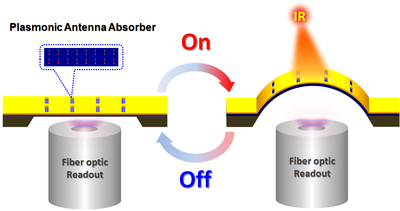Nanoantennas improve infrared sensing
Engineers at the University of Pennsylvania have used a pattern of nanoantennas to develop a new way of turning infrared light into mechanical action. The method opens the door to more sensitive infrared cameras and more compact chemical analysis techniques.
The research was conducted by assistant professor Ertugrul Cubukcu and postdoctoral researcher Fei Yi, along with graduate students Hai Zhu and Jason C Reed, all of the Department of Material Science and Engineering in Penn’s School of Engineering and Applied Science. It was published in the journal Nano Letters.
Detecting light in the mid-infrared range is important for applications like night-vision cameras as well as spectroscopy. Existing infrared detectors use cryogenically cooled semiconductors or thermal detectors known as microbolometers, in which changes in electrical resistance can be correlated to temperatures. These techniques require expensive, bulky equipment to be sensitive enough for spectroscopy applications.
“We set out to make an optomechanical thermal infrared detector,” Cubukcu said. “Rather than changes in resistance, our detector works by connecting mechanical motion to changes in temperature.”
This approach could reduce the footprint of an infrared sensing device to something that would fit on a disposable silicon chip. The researchers fabricated such a device in their study.
At the core of the device is a nanoscale structure - about a tenth of a millimetre wide and five times as long - made of a layer of gold bonded to a layer of silicon nitride. These materials have different thermal expansion coefficients, a parameter that determines how much material will expand when heated. Because metals will naturally convert some energy from infrared light into heat, researchers can connect the amount the material expands to the amount of infrared light hitting it.
“A single layer would expand laterally, but our two layers are constrained because they’re attached to one another,” Cubukcu said. “The only way they can expand is in the third dimension. In this case, that means bending towards the gold side, since gold has the higher thermal expansion coefficient and will expand more.”
To measure this movement, the researchers used a fibre interferometer. A fibre-optic cable pointed upwards at the system bounces light off the underside of the silicon nitride layer, enabling the researchers to determine how far the structure has bent upwards.
“We can tell how far the bottom layer has moved based on this reflected light,” Cubukcu said. “We can even see the displacements that are thousands of times smaller than a hydrogen atom.”

Other researchers have developed optomechanical infrared sensors based on this principle, but their sensitivities have been comparatively low. The new device is an improvement due to the inclusion of ‘slot’ nanoantennas - cavities that are etched into the gold layer at intervals that correspond to wavelengths of mid-infrared light.
“The infrared radiation is concentrated into the slots, so you don’t need any additional material to make these antennas,” Cubukcu said. “We take the same exact platform and, by patterning it with these nanoscale antennas, the conversion efficiency of the detector improves 10 times.”
The nanoantennas also provide the device with the ability to tailor which type of light it is sensitive to by etching a different pattern of slots on the surface.
“Other techniques can only work at the maximum absorption determined by the material itself,” Yi said. “Our antennas can be engineered to absorb at any wavelength.”
While it is only a proof-of-concept at this stage, future research will demonstrate the device’s capabilities as a low-case way of analysing individual proteins and gas molecules.
“We expect our approach, which combines nanoplasmonics with nanomechanical resonators, to lead to optically controlled nanomechanical systems enabling unprecedented functionality in biomolecular and toxic gas sensing and on-chip mass spectroscopy,” the researchers said.
Microplastics found to alter the human gut microbiome
Microplastic-treated cultures showed a consistent and significant increase in acidity (lower pH...
Sustainable, self-repairing, antimicrobial polymers developed
From medicine to electronics and optics, new materials developed by scientists at Kaunas...
A better way to create conductive polymers
New research disproves the longstanding belief that to create conductive polymers, substances...





